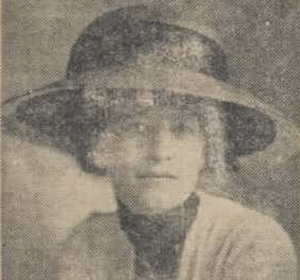Florence Aline Rodway facts for kids
Quick facts for kids
Florence Rodway
|
|
|---|---|
 |
|
| Born |
Florence Aline Rodway
11 November 1881 Hobart, Tasmania, Australia
|
| Died | 23 January 1971 (aged 89) Hobart, Tasmania, Australia
|
| Nationality | Australian |
| Education |
|
| Known for | pastel drawing, portraits, painting |
|
Notable work
|
|
Florence Aline Rodway (born November 11, 1881, died January 23, 1971) was a talented Australian artist. She was especially famous for painting amazing portraits of people. Florence was born in Hobart, Tasmania. She was the second of six children in her family.
Florence studied art at the Hobart Technical College. After two years, her artwork was so good that it was sent to London. She won a special scholarship to study painting. This allowed her to attend the Royal Academy of Arts in London. She painted many important people in Australian history. These included famous singer Dame Nellie Melba and writer Henry Lawson.
Contents
Early Life and Art Studies
Florence Aline Rodway was born in Hobart, Tasmania, on November 11, 1881. She had five brothers and was the second oldest child. Her father, Leonard Rodway, was a dentist and botanist. He moved to Australia from England.
Florence loved to draw from a young age. She was very good at it. She decided to study art at the Hobart Technical School. Her teacher was Benjamin Shepherd. After two years, her art samples were sent to London. This led to her winning a four-year scholarship. It was a huge achievement for an artist from Tasmania, especially for a woman back then!
Sadly, Florence could not finish her studies in London. It was too expensive to live there. So, she returned to Australia. She moved to Sydney, where she became a well-known artist.
Starting Her Career in Sydney
In Sydney, Florence opened her own art studio. She continued to learn and improve her skills. She studied with Sydney Long at the Julian Ashton Art School. Florence created drawings and illustrations for magazines. One of these was The Lone Hand.
She also joined the Society of Artists. She showed her work in their exhibitions. Florence became very skilled at using pastels. Pastels are like soft crayons that create beautiful, soft colours. People widely praised her pastel artwork. She was one of the few female artists. Critics said she was just as good as male artists. One critic even said her gender didn't matter. They said her talent was amazing.
In 1910, the Art Gallery of New South Wales bought one of her artworks. After this, her fame as a portrait artist grew even more. She painted many portraits using pastels. She was especially good at painting children. She was asked to paint famous people. These included Dame Nellie Melba and Henry Lawson.
Middle Years and Family Life
In 1914, Florence had her first solo art show. It was held at the Athenaeum Gallery in Melbourne. She showed 40 portraits and pastel drawings. Many of these works were borrowed from their owners. These owners were often the people Florence had painted. Famous people like Dame Nellie Melba and Julian Ashton lent their portraits.
A newspaper review in 1916 praised her work. It called her a "dealer in magic and spells." The review said her portraits were a main highlight. It mentioned a striking portrait of a strong young woman. It also loved her charming portraits of children.
Florence was asked to paint portraits for important public collections. The Art Gallery of New South Wales commissioned her. She painted J. F. Archibald in 1921. She also painted William Bridges in 1919. The Australian War Memorial also asked her for portraits. She painted William Bridges again in 1920. She also painted Henry Normand MacLaurin in 1922.
In 1920, Florence married Walter Moore. He was a civil engineer. They had a daughter named Suzanne in 1922. Having a family slowed down her art career a bit. But she still kept painting and showing her work. In 1928, she was chosen to represent Australia. Her art was shown in London. It was part of a big exhibition of art from across the Empire.
Later Years and Legacy
Florence and her family moved back to Hobart in 1932. She continued to show her paintings. In 1934, her work was in the Women Artists of Australia exhibition in Sydney. She also had two exhibitions with another Tasmanian artist, Edith Lilla Holmes. These shows were in Melbourne in 1948 and Hobart in 1953.
She also showed her art in exhibitions in 1950 and 1951. These were with the Melbourne Society of Women Painters and Sculptors. She kept exhibiting with The Art Society of Tasmania. She also showed work with the Tasmanian Group of Painters. Florence Rodway passed away in Hobart on January 23, 1971. Her beautiful portraits continue to be admired today.

